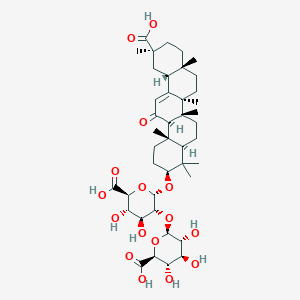Details of the Drug Inactive Ingredient (DIG)
| Full List of Biological Targets of DIG (DBTs) Regulated by This DIG | ||||||
|---|---|---|---|---|---|---|
| Oxidoreductase (ORase) | ||||||
| DBT Name: Dehydrogenase/reductase 9C 3 (11-DH2) | Click to Show/Hide | |||||
| Detailed Information |
DBT Info
 click to show the detail info of this DBT click to show the detail info of this DBT
|
|||||
| Experiment for Assessing the Biological Activity of the Studied DIG on This DBT | ||||||
| Biological Activity | IC50 = 0.4 nM (tested by experiment) | [1] | ||||
| Tested Species | Homo sapiens (Human) | |||||
| UniProt ID | DHI2_HUMAN | |||||
| DBT Name: Dehydrogenase/reductase 26C 1 (11-DH) | Click to Show/Hide | |||||
| Detailed Information |
DBT Info
 click to show the detail info of this DBT click to show the detail info of this DBT
|
|||||
| Experiment (1) for Assessing the Biological Activity of the Studied DIG on This DBT | ||||||
| Biological Activity | IC50 = 6 nM (tested by experiment) | [1] | ||||
| Tested Species | Homo sapiens (Human) | |||||
| UniProt ID | DHI1_HUMAN | |||||
| Experiment (2) for Assessing the Biological Activity of the Studied DIG on This DBT | ||||||
| Biological Activity | IC50 = 3 nM (tested by experiment) | [1] | ||||
| Tested Species | Mus musculus (Mouse) | |||||
| UniProt ID | DHI1_MOUSE | |||||
| Hydrolase (HDase) | ||||||
| DBT Name: Pancreatic alpha-amylase (AMYP) | Click to Show/Hide | |||||
| Detailed Information |
DBT Info
 click to show the detail info of this DBT click to show the detail info of this DBT
|
|||||
| Experiment for Assessing the Biological Activity of the Studied DIG on This DBT | ||||||
| Biological Activity | IC50 > 200000 nM (tested by experiment) | [2] | ||||
| Tested Species | Sus scrofa (Pig) | |||||
| UniProt ID | AMYP_PIG | |||||
| DBT Name: Protein-tyrosine phosphatase 1B (PTPN1) | Click to Show/Hide | |||||
| Detailed Information |
DBT Info
 click to show the detail info of this DBT click to show the detail info of this DBT
|
|||||
| Experiment for Assessing the Biological Activity of the Studied DIG on This DBT | ||||||
| Biological Activity | IC50 > 100000 nM (tested by experiment) | [3] | ||||
| Tested Species | Homo sapiens (Human) | |||||
| UniProt ID | PTN1_HUMAN | |||||
| Potential-driven transporter (PDT) | ||||||
| DBT Name: Solute carrier SLCO1B1 (OATP-C) | Click to Show/Hide | |||||
| Detailed Information |
DBT Info
 click to show the detail info of this DBT click to show the detail info of this DBT
|
|||||
| Experiment for Assessing the Biological Activity of the Studied DIG on This DBT | ||||||
| Biological Activity | Ki = 13 uM (tested by experiment) | [4] | ||||
| Tested Species | Homo sapiens (Human) | |||||
| UniProt ID | SO1B1_HUMAN | |||||
If you find any error in data or bug in web service, please kindly report it to Dr. Zhang and Dr. Mou.

